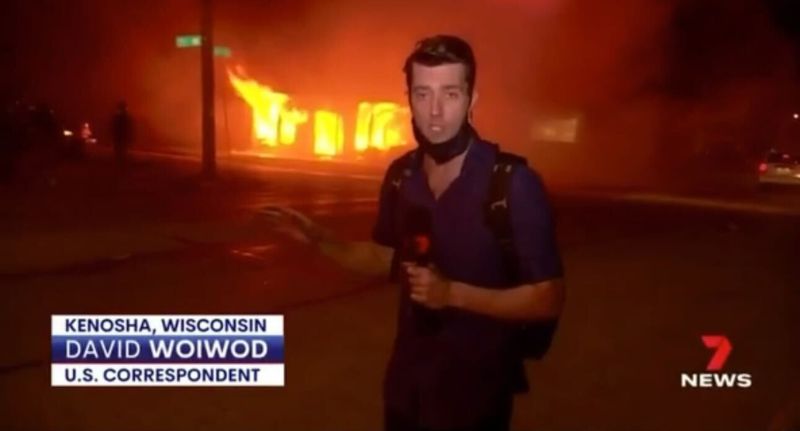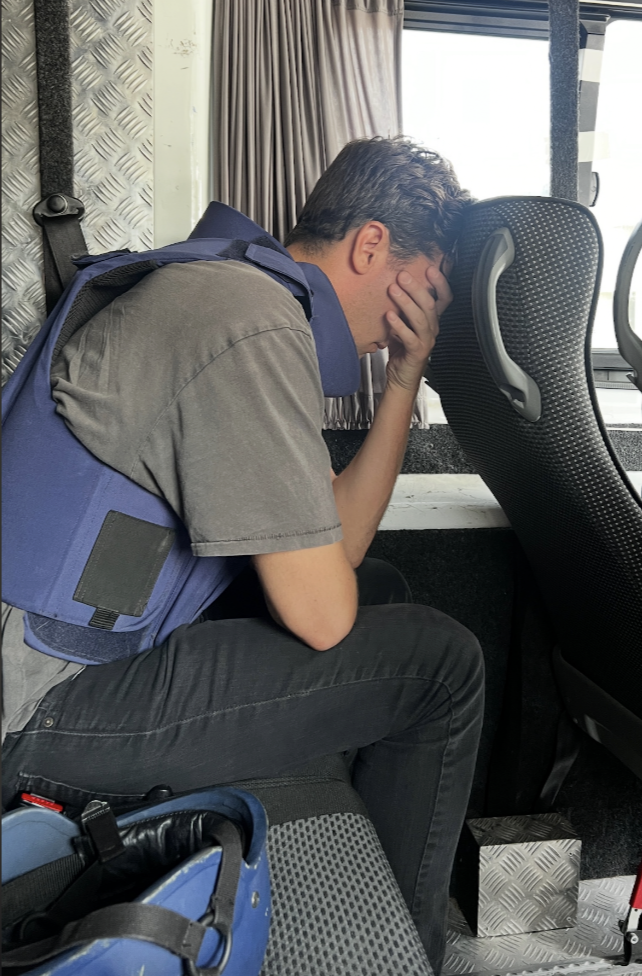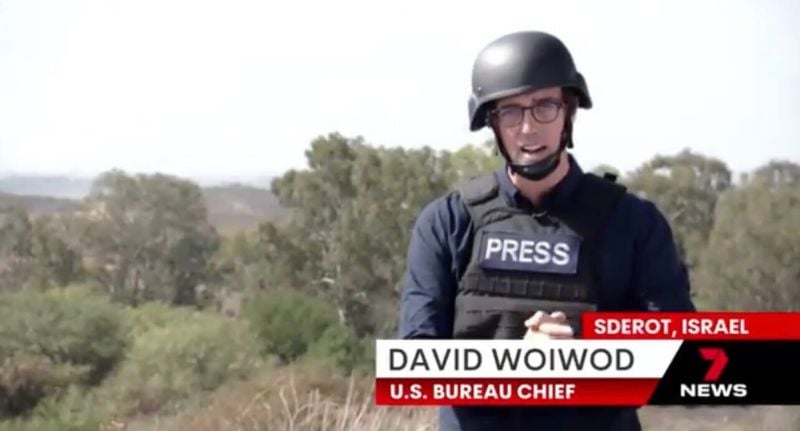When a flare exploded just metres from where 7NEWS correspondent David Woiwod was broadcasting live from the Gaza border, the chaos was instant: alarms screaming, crew members scattering, and a bomb shelter becoming the only plan.
It was the kind of moment that crystallises just how precarious frontline reporting can be, how quickly a news cross can tip into a survival story.
The dangers journalists face in conflict zones have been thrust back into the spotlight following this week’s violent incident that saw where 9News reporter Lauren Tomasi hit with a rubber bullet by police while covering protests in Los Angeles.
Meanwhile, reports out today claim a Nine cameraman was also injured by police while covering the riots, making him the fourth Australian journalist to be caught in the crossfire.
The incidents have sparked global outrage and underscored a sobering truth: whether it’s a warzone or a political rally, the line between observer and target is thinner than many realise.
In this Q&A, Woiwod opens up to Mediaweek about what it’s really like reporting amid rockets and resistance, and why, despite the fear, he keeps going back.

David Woiwod (back right), pictured with former UK Prime Minister Boris Johnson, former Australian Prime Minister Scott Morrison while touring Israel after October 7 attacks
Mediaweek: What has been the scariest moment for you while covering conflict and war zones?
Woiwod: Myself and the 7NEWS crew were reporting right on the border of Gaza, in the town of Sderot. I was broadcasting live on the early news, and the Israeli Defence Force had been sending up flares throughout the night. Because of the time difference, it was very late, pitch black except for those flares lighting up the sky.
They’d been using them to guide their troops in, so we’d seen them going up for hours. At one point, I said to Jodie Speers, who was hosting back in studio, ‘Oh, look, there’s one of those flares going up now.’ But as I said it, I realised it was getting bigger… and closer. Really close. That’s when all the air raid alarms went off.
Because of the studio lights in my face, I couldn’t see that the rest of the team, our cameraman, our security guard, our driver, and our fixer, had already taken off and were yelling my name. There was confusion, shouting, just pure adrenaline. I remember thinking, ‘Oh my God,’ and hoicking myself over a fence to get into the bomb shelter. The flare landed about 100 metres away. No one was hurt, thankfully, but it was a real wake-up call.
That was probably the scariest moment I’ve had. Once Hamas fires a missile at you, you kind of feel set to take on anything.

David Woiwod covering Kenosha riots back in 2020
Mediaweek: What about the Kenosha Riots? I remember watching you reporting from there and it seemed so dangerously intense.
Woiwod: I also covered the Kenosha riots in Wisconsin when I first arrived in the U.S. These were the race riots that erupted after police shot Jacob Blake, then, in the middle of it all, Kyle Rittenhouse shot and killed two people.
While we were there, we’d been hanging around near Kyle and his group. Whether we were actually with him, I still don’t really know. But we were close. They were letting their guns off, firing into the air like it was nothing.
The scene was chaos, buildings burning, people lighting things on fire. I saw someone pull over a light post, and when it crashed to the ground, the lamp caved in a man’s head right there on the footpath. It was that kind of night.
Mediaweek: Do you think journalists are being increasingly targeted while covering these kinds of stories?
Woiwod: It’s a tricky little balance, staying safe while also trying not to become a target yourself.
During those riots, protesters can see all your gear. The big camera, the mic, the nice clothes. You stick out. You are the media, and you’re not exactly blending in. It does feel like we’ve become targets now, especially with the rise of all this ‘fake news’ rhetoric. Sometimes I honestly think we’re even more of a target than the general public.
And it doesn’t matter if you’ve got a mainstream network behind you. Doesn’t matter what you’re saying, or how carefully you say it. There are people out there who just won’t accept it. They won’t respect the job you’re trying to do or your safety. It’s straight-up harassment.
I remember seeing images from the LA riots, NBC’s satellite truck completely defaced with anti-ICE graffiti. And I just thought, why? Why go after the truck? It made no sense. But in those moments, logic doesn’t matter. To some people, the media’s the enemy.

David Woiwod puts his head in his hands while sitting on a bus during his time covering the conflict in the Middle East
Mediaweek: How do reporters and crews prepare to head into a conflict zone?
Woiwod: Reporters need specialised training before they even set foot in a war zone. Things like hostile environment and first aid training, or HEFAT. Look, everyone’s done the course. It’s standard. But truthfully, heading into a conflict zone draws a particular type of person.
By the time you’re in that position, most of the people who wouldn’t cope have already been weeded out. The ones who end up on the ground are the ones who actually want to be there. They’ve trained for it, mentally and physically. They’ve got the drive. No one’s dragging them in against their will.
There’s something Darwinian about it. A kind of natural selection. The ones with the clearest sense of purpose and the sharpest instincts are the ones who make it through. And they’re the ones you’ll find reporting from the front line.
Mediaweek: What kind of support are reporters and crew offered when they return home?
Woidwod: They offer you all kinds of support once you return home.
I personally didn’t take it up because, at least for me, I felt a kind of disconnect between what I was seeing. I didn’t see it as a real part of my life because I was able to separate myself from the story I was covering. You need that detachment to be able to get through the job.
While I’m there covering the story, of course, I find it fascinating, but I have a job to do. I also like to put things in perspective.
We’ve got first responders here in Australia, including ambos, paramedics, police, doctors, nurses, and firefighters, who witness the worst of the worst daily.
While it might not be a war zone, they’re still attending horrific scenes like car crashes, train derailments or domestic violence murders. They are still seeing the worst of the worst.
Mediaweek: Is there ever a ‘typical day’ when you’re out there covering a conflict zone?
Woiwod: By the very nature of the stuff we’re covering, there’s no ‘typical day’. It’s just so unpredictable and so volatile.
I remember when we were in Israel just after the October 7 attacks, at the very height of that conflict, missiles were coming over into Israel all the time. So people are living with that fear.
You’d be in bed, and every few hours or every 45 minutes, there’s another barrage of missiles coming over. So you’re running into the bomb shelters or stairwells throughout the night.
After a while, a desensitising effect takes place.
With riots, especially the ones happening in LA at the moment, there’s a real organisation to them. Our role is to stay informed and know when they’re planning things, so we can determine when to deploy our crews. Our days are dictated mainly by things like that.

David Woiwod (back right), pictured with his fellow 7NEWS colleague Chris Reason (front right) touring Israel after October 7 attacks
Mediaweek: You’re currently sitting behind the desk as the co-host for Weekend Sunrise. Do you miss covering those intense stories?
Woiwod: I haven’t… until this week.
The LA riots are taking place in a city that I lived in for five years. They’re happening in my old backyard. This is the first time that I’ve felt that desperation to get back out on the road.
But even being behind the desk presents an incredible opportunity to be part of the story in a different way. On Monday, we transitioned to rolling coverage, which was fascinating for me to experience firsthand and see the crew at work.
We also have an amazing and skilled crew. Being behind the desk meant I could offer assistance to those crews out on the road and help them with the news they couldn’t see, as you do fly a little bit blind in those situations.
Now, I’ve got the opportunity to zoom out and take in the whole picture.
We’ve many reporters who do this. You look at 7NEWS reporters like Chris Reason, Hugh Whitfield, Ashley Mullaney, Mylee Hogan, and Sarah Greenhalgh. We’ve all been running from those scenes for years.
It’s intense and wild, but it’s also why we love the job, because you’re witnessing history unfolding right before your eyes.
David Woiwod can be seen on Weekend Sunrise every Saturday and Sunday from 7am on 7 and 7plus
